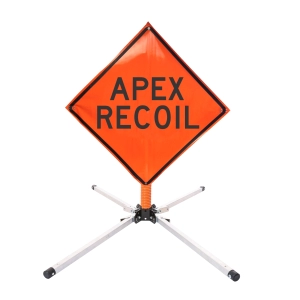1
Apr
Work Zone Safety: Understanding and Implementing MASH Approved Sign Stands
 Work Zone Safety: Understanding and Implementing MASH Approved Sign Stands
Work Zone Safety: Understanding and Implementing MASH Approved Sign Stands
For professionals in traffic management and construction, ensuring the safety of both road users and work crews is a paramount responsibility. Temporary traffic control devices, particularly sign stands, play a critical role in achieving this. However, the performance of these devices under vehicle impact is a crucial factor often requiring deeper consideration. This article will focus on the significance of MASH approved sign stands, the implications of the FHWA's mandates, a clear understanding of MASH, and the role of manufacturers like Eastern Metal in providing compliant and crash tested sign stands.
The Mandate for MASH Compliance
The Federal Highway Administration (FHWA) has established the Manual for Assessing Safety Hardware (MASH) as the current standard for evaluating the crashworthiness of roadside safety hardware. Superseding NCHRP Report 350, MASH incorporates contemporary vehicle fleet characteristics, refined testing procedures, and more stringent evaluation criteria. While specific sunset dates for temporary traffic control devices have passed, adherence to MASH standards represents a critical benchmark for professional practice in temporary traffic control. Utilizing MASH-compliant devices is essential for mitigating liability and ensuring the highest level of safety in temporary traffic management zones.
Deconstructing MASH: Key Considerations for Professionals
MASH provides a comprehensive framework for assessing the safety performance of roadside hardware under various impact scenarios. Key elements relevant to the selection and implementation of temporary sign stands include:
- Updated Vehicle Fleet Representation: MASH testing protocols utilize heavier and larger test vehicles (passenger cars and pickup trucks) reflecting the current vehicle mix on roadways. This provides a more realistic assessment of impact severity.
- Revised Impact Parameters: Impact angles and speeds in MASH testing are calibrated to represent a broader spectrum of real-world crash conditions, demanding higher performance standards from safety hardware.
- Rigorous Evaluation Metrics: MASH employs detailed evaluation criteria encompassing structural adequacy, occupant risk (measured through metrics like ASI, THIV, and PHD), and post-impact vehicle trajectory. Professionals must understand these metrics to appreciate the performance capabilities of MASH-compliant devices.
- Test Levels (TLs): MASH defines six test levels (TL-1 through TL-6), each corresponding to increasing impact severity. For temporary traffic control, TL-2 and TL-3 are particularly relevant, dictating the performance requirements for sign stands based on anticipated traffic volumes and speeds. Specifying the appropriate TL for a given application is a critical professional decision.
The Engineering Behind Crash Tested Sign Stands
Traditional, non-crashworthy sign stands pose a significant hazard upon vehicle impact, potentially leading to vehicle damage, occupant injury, and secondary collisions. Crash tested sign stands, engineered according to MASH criteria, incorporate specific design features to mitigate these risks. The breakaway mechanism is central to their functionality, designed to activate upon impact in a predictable and controlled manner. This mechanism aims to:
- Minimize Deceleration Forces: By fracturing or yielding upon impact, the sign stand reduces the abrupt deceleration forces transmitted to the vehicle and its occupants, thereby lowering the risk of injury.
- Prevent Occupant Compartment Intrusion: Properly designed MASH-compliant stands ensure that components of the sign stand and the sign itself do not penetrate the vehicle's occupant compartment, a critical factor in preventing severe injuries.
- Control Debris Generation: The breakaway action is engineered to produce smaller and less hazardous debris compared to the fragmentation of a rigid structure.
- Maintain Predictable Vehicle Trajectory: A key performance criterion under MASH is the post-impact trajectory of the vehicle. MASH-compliant sign stands are designed to allow the vehicle to continue on a relatively stable path, minimizing the potential for loss of control or collisions with other vehicles or hazards.
Eastern Metal: Providing MASH Compliant Solutions
Eastern Metal Signs and Safety, a manufacturer based in Elmira, NY, offers a range of crash tested sign stands engineered to meet the rigorous requirements of the FHWA and MASH. Their commitment to compliance provides professionals with reliable options for enhancing work zone safety. Their APEX series, for example, often features MASH approved sign stands designed for both roll-up and rigid signs. Key engineering considerations in these products include:
- Optimized Breakaway Designs: Engineered fracture points and material selection ensure consistent and predictable breakaway performance across a range of impact conditions within the specified MASH TL.
- Aerodynamic Considerations: Designs are often evaluated for wind resistance to ensure stability under operational conditions without compromising breakaway functionality during an impact.
- Durable and Field-Deployable Systems: Professional-grade sign stands from Eastern Metal are designed for repeated use, ease of deployment and retrieval, and durability in demanding work zone environments.
- Specific MASH TL Ratings: Professionals should consult product specifications to ensure the selected sign stands meet the appropriate MASH Test Level (typically TL-2 or TL-3) for the intended application based on traffic volume and speed.
Conclusion: A Professional Imperative for MASH Compliance
For traffic engineers, construction managers, and safety officers, the selection and implementation of temporary traffic control devices must be guided by the latest safety standards. MASH approved sign stands are no longer simply a recommended practice; they represent a critical component of a professional commitment to minimizing risk and enhancing safety in temporary traffic management zones. By understanding the principles of MASH, the performance characteristics of crash tested sign stands from reputable manufacturers like Eastern Metal, and the FHWA's guidance, professionals can make informed decisions that contribute to safer roadways for all.

 Work Zone Safety: Understanding and Implementing MASH Approved Sign Stands
Work Zone Safety: Understanding and Implementing MASH Approved Sign Stands

